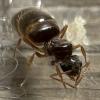I caught this queen yesterday (8/26) at around noon. she is 9mm long, has fat legs, and struggles to climb glass. If she is Lasius latipes, how do I care for her? Thank you.

Edited by Jonathan5608, August 27 2023 - 11:19 AM.
Keeping:
1x - S. molesta REBOOT (founding) 1x - C. pennsylvanicus (founding) ![]() New!
New!
2x - C. chromaiodes (founding queen and colony)
1x - T. sessile (mega colony)
1x - C. nearcticus (alate ==> founding?)
Check out my C. nearcticus journal here: https://www.formicul...cticus-journal/
Check out my C. chromaiodes journal here: https://www.formicul...aiodes-journal/
I caught this queen yesterday (8/26) at around noon. she is 9mm long, has fat legs, and struggles to climb glass. If she is Lasius latipes, how do I care for her? Thank you.
How'd she make out?
How'd she make out?
Unfortunately, she died shortly after this post, before I could even start thinking about finding host brood.
How'd she make out?
Unfortunately, she died shortly after this post, before I could even start thinking about finding host brood.
Would love to have that species and they are native to my area. Maybe she died of stress, because you said she could not climb glass, and some species, like Pogonomyrmex die of stress when they can’t get a good grip on surfaces. One time I had it happen to me, now whenever I capture ants in my capture vial, I like to put something like a leaf so they can grip
Edited by OwlThatLikesAnts, February 24 2025 - 7:53 AM.
Currently keeping:
1x Formica subsericea, 35-40 workers + maybe eggs
1x Crematogaster cerasi, only queen now, workers ded ![]() *internal screaming*
*internal screaming*
1x Myrmica ruba sp around 10 workers + pupa
*New* 1x founding Camponotus pennsylvanicus + eggs that die (probably infertile)
*New* 2x Camponotus nova, one is infertile
*As you watch your ants march, remember that every thing begins with a small step and continued by diligence and shared dreams*
-A.T (which is Me)
0 members, 0 guests, 0 anonymous users